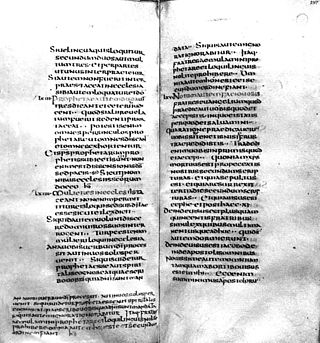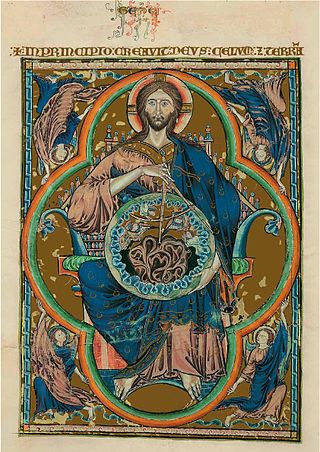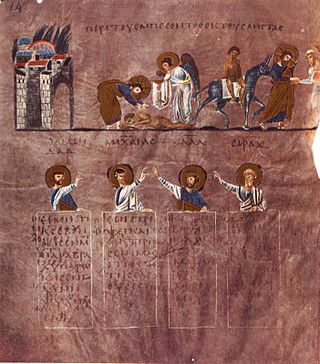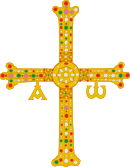
The Vulgate, sometimes referred to as the Latin Vulgate, is a late-4th-century Latin translation of the Bible.

The Kingdom of Asturias was a kingdom in the Iberian Peninsula founded by the Visigothic nobleman Pelagius. It was the first Christian political entity established after the Umayyad conquest of Visigothic Hispania in 711. In 718 or 722, Pelagius defeated an Umayyad army at the Battle of Covadonga, in what is usually regarded as the beginning of the Reconquista.
The Johannine Comma is an interpolated phrase (comma) in verses 5:7–8 of the First Epistle of John.

British Library, Add MS 40618 is a late 8th century illuminated Irish Gospel Book with 10th century Anglo-Saxon additions. The manuscript contains a portion of the Gospel of Matthew, the majority of the Gospel of Mark and the entirety of the Gospels of Luke and John. There are three surviving Evangelist portraits, one original and two 10th century replacements, along with 10th century decorated initials. It is catalogued as number 40618 in the Additional manuscripts collection at the British Library.

The Codex Beneventanus is an 8th-century illuminated codex containing a Gospel Book. According to a subscription on folio 239 verso, the manuscript was written by a monk named Lupus for one Ato, who was probably Ato, abbot (736–760) of the monastery of San Vincenzo al Volturno, near Benevento. The unusual odd number of Canon Tables suggests these seven folios were prepared as much as two centuries earlier than the rest of the codex.

Pre-Romanesque art and architecture is the period in European art from either, the emergence of the Merovingian kingdom in about 500 AD or from the Carolingian Renaissance in the late 8th century, to the beginning of the 11th century Romanesque period. The term is generally used in English only for architecture and monumental sculpture, but here all the arts of the period are briefly described.

British Library, Egerton MS 609 is a Breton Gospel Book from the late or third quarter of the ninth century. It was created in France, though the exact location is unknown. The large decorative letters which form the beginning of each Gospel are similar to the letters found in Carolingian manuscripts, but the decoration of these letters is closer to that found in insular manuscripts, such as the Book of Kells and the Lindisfarne Gospels. However, the decoration in the Breton Gospel Book is simpler and more geometric in form than that found in the Insular manuscripts. The manuscript contains the Latin text of St Jerome's letter to Pope Damasus, St. Jerome's commentary on Matthew, and the four Gospels, along with prefatory material and canon tables. This manuscript is part of the Egerton Collection in the British Library.

The Codex Fuldensis, also known as the Victor Codex, designated by F, is a New Testament manuscript based on the Latin Vulgate made between 541 and 546. The codex is considered the second most important witness to the Vulgate text; and is also the oldest complete manuscript witness to the order of the Diatessaron. It is an important witness in any discussion about the authenticity of 1 Corinthians 14:34–35 and the Comma Johanneum. It is one of the earliest dated manuscripts of the New Testament. It was corrected until 2 May, 546 AD.

The Fécamp Bible is an illuminated Latin Bible. It was produced in Paris during the third quarter of the 13th century, and had previously belonged in the collection of Henry Yates Thompson.

The Bible of St Louis, also called the Rich Bible of Toledo or simply the Toledo Bible, is a Bible moralisée in three volumes, made between 1226 and 1234 for King Louis IX of France at the request of his mother Blanche of Castile. It is an illuminated manuscript that contains selections of the text of the Bible, along with a commentary and illustrations. Each page pairs Old and New Testament episodes with illustrations explaining their moral significance in terms of typology. Every excerpt of the Bible is illustrated with two miniatures. The first shows a representation of the text fragment as such, the second shows a theological or an allegorical scene explaining the text fragment in the light of the teachings of the Church. The miniatures are accompanied by the Bible text and by a short comment on the typological relationship between the two images.

Purple parchment or purple vellum refers to parchment dyed purple; codex purpureus refers to manuscripts written entirely or mostly on such parchment. The lettering may be in gold or silver. Later the practice was revived for some especially grand illuminated manuscripts produced for the emperors in Carolingian art and Ottonian art, in Anglo-Saxon England and elsewhere. Some just use purple parchment for sections of the work; the 8th-century Anglo-Saxon Stockholm Codex Aureus alternates dyed and un-dyed pages.
The Codex Complutensis I, designated by C, is a 10th-century codex of the Christian Bible. It is written on vellum with Latin text mainly following the Vulgate. Parts of the Old Testament present an Old Latin version.

Lectionary 226, designated by siglum ℓ226 is a Greek manuscript of the New Testament, on parchment. Palaeographically it has been assigned to the 14th century. F. H. A. Scrivener labelled it by 249evl. Some leaves of the manuscript were lost, and some leaves have survived in a fragmentary condition.

The Codex Toletanus, designated by T, also called Biblia hispalense or Seville Bible, is a 10th-century Latin manuscript of the Old and New Testament. The text, written on vellum, is a version of the Latin Vulgate Bible, which contains the entire Bible, including the trinity reference Comma Johanneum.
The Codex Theodulphianus, designated Θ, is a 10th-century Latin manuscript of the Old and New Testament. The text, written on vellum, is a version of the Latin Vulgate Bible. It contains the whole Bible, with some parts written on purple vellum.
The León Palimpsest, designated l or 67, is a 7th-century Latin manuscript pandect of the Christian Bible conserved in the cathedral of León, Spain. The text, written on vellum, is in a fragmentary condition. In some parts it represents the Old Latin version, while following Jerome's Vulgate in others. The codex is a palimpsest.

The Codex Sangallensis 63, designated by S in some critical editions of the Bible, is a 9th-century Latin manuscript of the New Testament. The text, written on vellum, is a version of the Vulgate and contains the text of the Acts of the Apostles, Epistles, Book of Revelation, and non-biblical material. The manuscript has not survived in a complete condition, some parts of it have been lost. The original manuscript did not contain the Comma Johanneum, but it was added by a later hand on the margin.

The Codex Sangallensis 907, designated S, is an 8th-century Latin manuscript of the New Testament. The text, written on vellum, is a version of the Latin Vulgate Bible. It contains the text of the Catholic epistles, Book of Revelation, and non-biblical material. The manuscript did not survived in a complete condition and some parts of it has been lost. The codex contains the Comma Johanneum.

The Biblioteca statale del Monumento Nazionale Badia di Cava or the State Library of the National Monument of the Abbey of Cava de' Tirreni, is a national library whose collection originated with works from the Benedictine abbey of La Trinità della Cava, located on Via Michele Morcaldi 6, Cava de' Tirreni, province of Salerno, region of Campania, Italy.

The Spanish illumination of the Early Middle Ages is the art of decorating books that developed in Spain from the to the 11th. The country was marked by the Muslim occupation from 711, which tended to isolate it from the rest of Europe. In the regions that remained Christian, first in the Kingdom of Asturias and then in León, an original art was invented in monasteries, mixing Visigothic, Carolingian, and also Moorish influences.

















